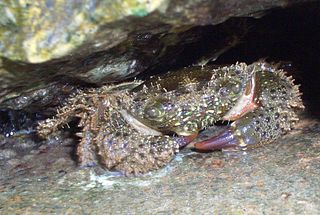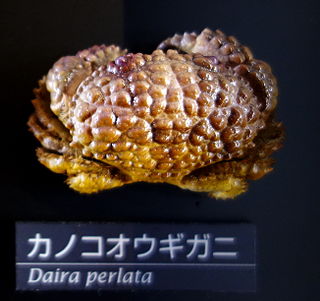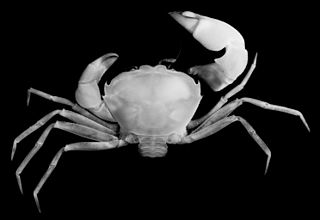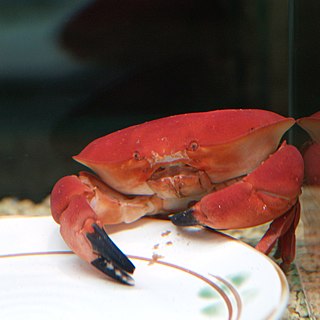
The Decapoda or decapods are an order of crustaceans within the class Malacostraca, including many familiar groups, such as crayfish, crabs, lobsters, prawns, and shrimp. Most decapods are scavengers. The order is estimated to contain nearly 15,000 species in around 2,700 genera, with around 3,300 fossil species. Nearly half of these species are crabs, with the shrimp and Anomura including hermit crabs, porcelain crabs, squat lobsters making up the bulk of the remainder. The earliest fossil decapod is the Devonian Palaeopalaemon.

Portunidae is a family of crabs which contains the swimming crabs.

The Majoidea are a superfamily of crabs which includes the various spider crabs.

Discoplax is a genus of terrestrial crabs. It is very closely related to the genus Cardisoma.

Eriphia is a genus of crabs, including the following species:

Atelecyclidae is a family of crabs belonging to the superfamily Cancroidea, and currently contains eight genera of which two are extinct. However, the genera other than Atelecyclus and Pseudocorystes do not belong in the Cancroidea, and are to be removed from the family.

Pilumnoidea is a superfamily of crabs, whose members were previously included in the Xanthoidea. The three families are unified by the free articulation of all the segments of the male crab's abdomen and by the form of the gonopods. The earliest fossils assigned to this group are of Eocene age.

Dairoidea is a superfamily of crabs, comprising two families which each contain a single genus: Dairidae and Dacryopilumnidae (Dacryopilumnus) .

Pseudozioidea is a superfamily of crabs, formerly treated in the Eriphioidea, Carpilioidea, Xanthoidea, Pilumnoidea and Goneplacoidea. A number of fossils from the Eocene onwards are known from the family Pseudoziidae. Eleven genera are recognised in three families:
Palicoidea is a superfamily of crabs, comprising the two families Crossotonotidae and Palicidae. Together, they contain 13 genera, including two genera in the Palicidae known only from fossils. The two families were previously treated as two subfamilies in a Palicidae of wider circumscription.

Planes is a genus of crabs in the family Grapsidae that currently comprises three extant species: Planes minutus, Planes marinus Rathbun, 1914, and Planes major (=cyaneus). A further fossil species is known from the Middle Miocene of the Caucasus.

Xantho is a genus of crabs in the family Xanthidae, containing five extant species, all restricted to the north-east Atlantic Ocean and Mediterranean Sea, although Xantho granulicarpis is not universally recognised as a separate species from Xantho hydrophilus:
Vellodius etisoides is a species of crab in the family Xanthidae. It was originally described as Pilodius etisoides, but was transferred to the monotypic genus Vellodius in 1998. It is found around Amami Ōshima in the Ryūkyū Islands, and the Paracel Islands in the South China Sea.
Danielea moelensis is a species of crab in the family Xanthidae, and the only species in the genus Danielea.
Polydectus cupulifer is a species of crab in the family Xanthidae, and the only species in the genus Polydectus. Together with the genus Lybia, it forms the subfamily Polydectinae. It is found in the Indo-Pacific, ranging from Madagascar and the Red Sea in the west to Japan, Hawaii and French Polynesia in the east. P. cupulifer is densely covered with setae (bristles), and frequently carries a sea anemone in each chela (claw).
Jacforus cavatus is a species of crab in the monotypic genus Jacforus in the family Xanthidae.
Marratha angusta is a species of crabs in the family Xanthidae, the only species in the genus Marratha. It was originally described as Cycloxanthops angustus by Mary J. Rathbun in 1906, but was moved to a new genus in 2003; the name of the genus, Marratha, is an "arbitrary abbreviation" of Rathbun's name. It has been recorded from the Amirante Islands (Seychelles), Hawaii and the South China Sea.

Cyclograpsus is a genus of crabs, containing the following species:

Goneplax is a genus of crabs, containing the following extant species:

Atergatis subdentatus, also known as the red reef crab, dark-finger coral crab or eyed coral crab, is a species of crab in the family Xanthidae.















